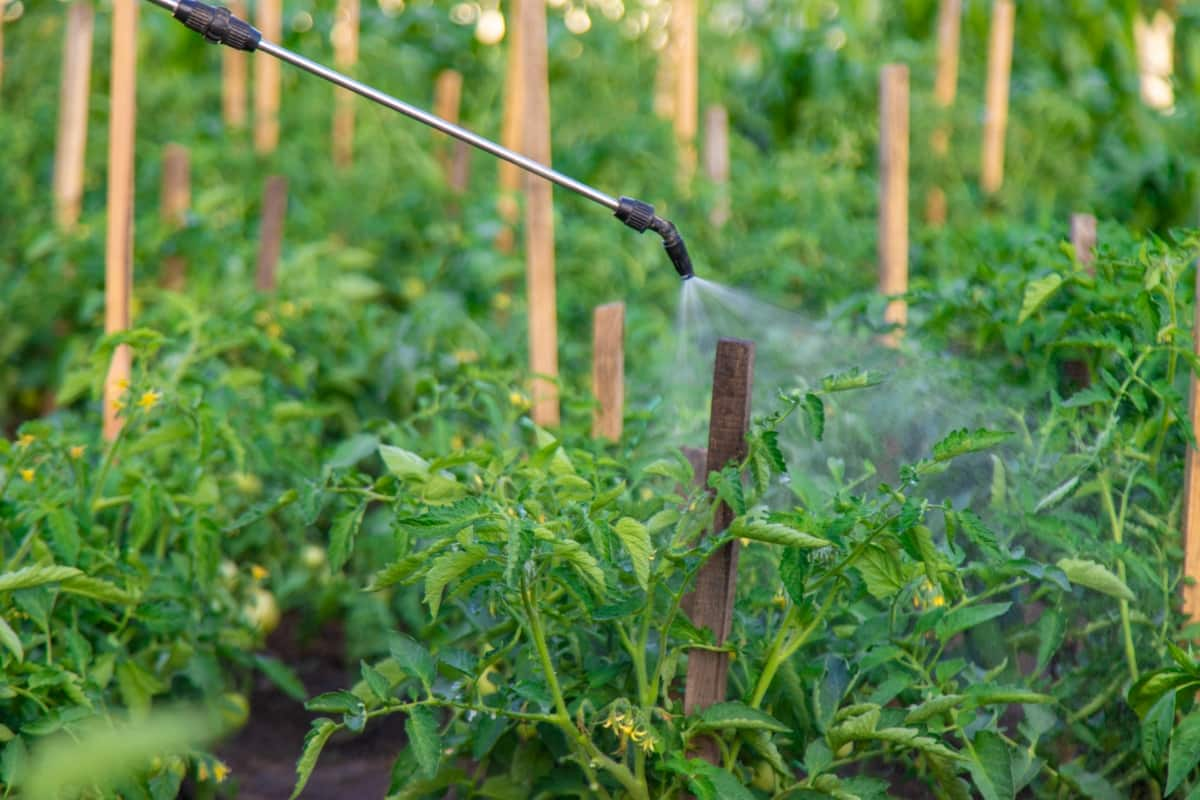Neem oil is a beneficial organic solution for tomato plants due to its versatile properties. Rich in azadirachtin, neem oil is a potent natural pesticide, deterring common tomato pests like aphids, whiteflies, and caterpillars. Its antimicrobial properties also combat fungal infections such as blight and powdery mildew, common issues in tomato cultivation.

Neem oil is easily absorbed by plant tissues, enhancing the plant’s immune system and promoting overall health. Regular application helps prevent disease outbreaks and supports robust tomato growth. Additionally, neem oil is environmentally friendly, posing minimal harm to beneficial insects and ecosystems.
Using Neem Oil on Tomato Plants
How to Use Neem Oil to Protect Your Tomato Plants from Pests: A Step-By-Step Guide
- Mix neem oil with water according to package instructions. Typically, use 1-2 tablespoons of neem oil per gallon of water.
- Choose a calm morning to apply neem oil. Early hours allow the oil to dry before the heat of the day.
- Use a garden sprayer to evenly coat both sides of tomato leaves evenly, focusing on the undersides where pests often reside.
- Apply neem oil once a week or as needed, especially after rainfall. Consistent application builds a protective barrier.
- Direct attention to areas prone to pests, such as new growth and flowering parts.
- Spray the soil around the tomato plants to deter soil-dwelling pests and fungal growth.
- Apply neem oil in the early morning or late afternoon to prevent sun stress on the plants.
How Neem Oil Works to Shield Tomato Plants from Diseases: The Science Explained
Neem oil’s efficacy in protecting tomato plants stems from its complex biochemistry. The key active ingredient, azadirachtin, disrupts the life cycle of many pests, acting as an insect growth regulator. It hinders feeding, molting, and egg-laying, reducing pest populations.
Additionally, neem oil exhibits antifungal properties, combating pathogens that cause diseases like blight and powdery mildew. The oil forms a protective layer on plant surfaces, preventing fungal spores from germinating. Neem oil also stimulates the plant’s immune system, promoting the production of defensive compounds. As a result, the overall health of tomato plants improves, making them more resilient to diseases.
Making a Neem Oil Solution for Taking Care of Your Tomato Plants: A Detailed Walkthrough
Mix 1-2 tablespoons of neem oil with 4 liters of water to create a neem oil solution for tomato plants. Add some mild dish soap liquid to help emulsify the oil. Stir well to achieve a homogeneous solution. Pour the mixture into a garden sprayer. Choose a calm morning and spray the solution evenly on both sides of tomato leaves, focusing on pest-prone areas.
In case you missed it: How to Use Baking Soda to Prevent Tomato Blossom End Rot

Ensure thorough coverage. Apply weekly or as needed, especially after rain. This organic solution harnesses neem oil’s insect-repelling and antifungal properties to protect and enhance the overall health of your tomato plants.
Recognizing Common Pests on Tomato Plants and Treating Them with Neem Oil
Identifying common pests on tomato plants, such as aphids, whiteflies, and caterpillars, is crucial. Inspect the underside of leaves and new growth regularly. To treat infestations, prepare a neem oil solution by mixing 1-2 tablespoons of neem oil with 4 liters of water and a few drops of mild soap.
Use a garden sprayer to evenly coat affected areas. Neem oil disrupts the pests’ life cycle, deters feeding, and acts as a natural insecticide. Apply weekly, focusing on pest-prone zones. This organic approach harnesses neem oil’s properties to combat infestations and promote the overall health of tomato plants.
Getting the Most out of Neem Oil for Your Tomato Plants: What to Do and What to Avoid
To maximize the benefits of neem oil for your tomato plants, dilute it as directed, usually 1-2 tablespoons per gallon of water, and add a few drops of mild soap. Apply early in the morning to allow for drying before intense sunlight. Ensure thorough coverage on both sides of leaves, especially undersides where pests reside. Use consistently, ideally weekly or as needed, and particularly after rainfall.
Monitor for pests and diseases regularly. However, avoid excessive applications, as neem oil can suffocate plants if overused. Also, refrain from applying during extreme heat to prevent sun stress. Additionally, integrate good gardening practices, such as proper spacing and soil maintenance, to fortify the overall resilience of your tomato plants.
When and How Often to Apply Neem Oil to Tomato Plants for Best Results
Apply neem oil to tomato plants in the early morning or late afternoon to avoid sun stress. Start when plants are established, typically after the seedling stage. For prevention, apply the neem oil solution weekly, especially during the growing season or when conditions favor pest and disease development. Increase the frequency if you notice pest activity or disease symptoms.
In case you missed it: Tomato Farming in the Fall: Instructions to Grow Tomatoes in the Cooler Months

After heavy rain, reapply to maintain protection, as rain may wash away the oil. Always follow package instructions for dilution ratios and application guidelines. Consistent and regular application is key to harnessing neem oil’s protective properties, promoting a healthy tomato crop, and preventing infestations and diseases throughout the growing season.
Fixing Common Problems When Using Neem Oil on Tomato Plants: Tips and Solutions
If experiencing issues with neem oil on tomato plants, ensure proper dilution, adhering to recommended ratios. Address potential clogging using a well-strained sprayer and shaking the solution before application. If residue appears on leaves, reduce oil concentration. To mitigate plant sensitivity, water plants a day before application and avoid treating stressed or extremely hot plants.
If pests persist, consider adjusting the application frequency or exploring complementary pest control methods. Also, consult local gardening resources for guidance on neem oil use in your region. Regular monitoring and adaptable application strategies help overcome challenges, ensuring successful neem oil utilization for tomato plant care.
Combining Neem Oil with a Holistic Approach to Keep Your Tomato Plants Healthy
For comprehensive tomato plant care, integrate neem oil with a holistic approach. Prioritize soil health through organic amendments and proper watering to enhance plant resilience. Ensure adequate spacing for good air circulation, preventing fungal issues. Companion planting with pest-repelling herbs like basil can complement neem oil’s effectiveness.
Regularly inspect plants for pests and diseases, addressing issues promptly. Rotate crops yearly to disrupt pest cycles. Employ natural predators like ladybugs. Use neem oil preventively consistently, adjusting frequency based on environmental conditions. This combined strategy creates a robust defense, promoting your tomato plants’ overall health and productivity in a sustainable and environmentally friendly manner.
Long-Term Benefits of Neem Oil for Tomato Plants: Boosting Growth and Yield
Neem oil offers enduring advantages for tomato plants, fostering long-term growth and increased yields. Its natural composition fortifies the plant’s immune system, making tomatoes more resilient to pests and diseases over successive growing seasons. By disrupting the life cycles of common pests, neem oil maintains a sustainable defense mechanism. Consistent use enhances overall plant vitality, ensuring bountiful harvests. The long-term application of neem oil safeguards tomato plants and sustains their growth, resulting in healthier, more productive crops year after year.
In case you missed it: Tomato Farming with Mulch: How to Use Organic Materials for Better Soil Health and Yield

Conclusion
In conclusion, incorporating neem oil into your tomato plant care routine offers a natural, effective pest and disease management solution. The step-by-step guide provides a clear pathway to harness neem oil’s benefits, promoting the health and resilience of your tomato plants. With its organic properties, neem oil protects and nurtures, ensuring a thriving tomato crop for the long term.
- Feed Your Flock for Less: Top 10 Tips to Save on Chicken Feed
- Ultimate Guide to Ossabaw Island Hog: Breeding, Raising, Diet, and Care
- Hatching Answers: The Top 10 Reasons Your Chickens Aren’t Laying Eggs
- Eggs and Economics: Breaking Down the Cost of Raising Backyard Chickens
- Defend Your Greens: Proven Methods to Keep Iguanas Out of Your Garden
- Ultimate Guide to Cinnamon Queen Chicken: A Comprehensive Guide for Beginners
- Ultimate Guide to California Tan Chicken: Breeding, Raising, Diet, Egg-Production and Care
- Ultimate Guide to Marsh Daisy Chicken: Breeding, Raising, Diet, and Care
- 10 Types of Chicken Farming Businesses You Can Start for Profits